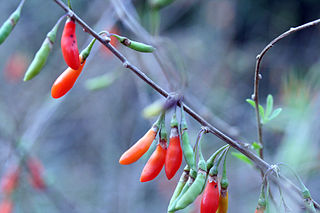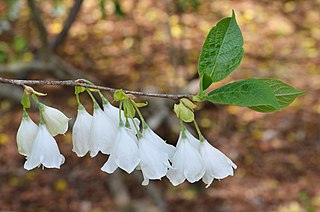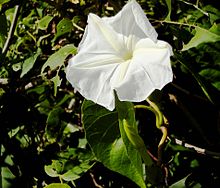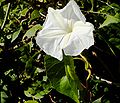
Ipomoea corymbosa is a species of morning glory, native throughout Latin America from Mexico as far south as Peru and widely naturalised elsewhere. Its common names include Christmasvine, Christmaspops, and snakeplant.

Morning glory is the common name for over 1,000 species of flowering plants in the family Convolvulaceae, whose current taxonomy and systematics are in flux. Morning glory species belong to many genera, some of which are:

Ergine, also known as d-lysergic acid amide (LSA) and d-lysergamide, is an ergoline alkaloid that occurs in various species of vines of the Convolvulaceae and some species of fungi. The psychedelic properties in the seeds of ololiuhqui, Hawaiian baby woodrose and morning glories have been linked to ergine and/or isoergine, its epimer, as it is the dominant alkaloid present in the seeds.

Catharanthus is a genus of flowering plants in the family Apocynaceae. Like the genus Vinca, they are known commonly as periwinkles. There are eight known species. Seven are endemic to Madagascar, though one, C. roseus, is widely naturalized around the world. The eighth species, C. pusillus, is native to India and Sri Lanka. The name Catharanthus comes from the Greek for "pure flower".

Ergoline is a chemical compound whose structural skeleton is contained in a variety of alkaloids, referred to as ergoline derivatives or ergoline alkaloids. Ergoline alkaloids, one being ergine, were initially characterized in ergot. Some of these are implicated in the condition ergotism, which can take a convulsive form or a gangrenous form. Even so, many ergoline alkaloids have been found to be clinically useful. Annual world production of ergot alkaloids has been estimated at 5,000–8,000 kg of all ergopeptines and 10,000–15,000 kg of lysergic acid, used primarily in the manufacture of semi-synthetic derivatives.

Ipomoea is the largest genus in the flowering plant family Convolvulaceae, with over 600 species. It is a large and diverse group, with common names including morning glory, water convolvulus or kangkung, sweet potato, bindweed, moonflower, etc.

Argyreia nervosa is a perennial climbing vine native to the Indian subcontinent and introduced to numerous areas worldwide, including Hawaii, Africa, and the Caribbean. Though it can be invasive, it is often prized for its aesthetic and medicinal value. Common names include Hawaiian baby woodrose, adhoguda अधोगुडा or vidhara विधारा (Sanskrit), elephant creeper and woolly morning glory. Its seeds are known for their powerful entheogenic value, greater or similar to those of varieties from the Convolvulaceae family, with users reporting significant psychedelic and spiritual experiences. The two botanical varieties are A. n. var. nervosa described here, and A. n. var. speciosa, which are used in Ayurvedic medicine for their medicinal value.

Xanthocercis is a tree genus in the family Fabaceae. Species include:

Ipomoea alba, sometimes called the tropical white morning-glory or moonflower or moon vine, is a species of night-blooming morning glory, native to tropical and subtropical regions of North and South America, from Argentina to northern Mexico, Florida and Puerto Rico. Though formerly classified as genus Calonyction, species aculeatum, it is now properly assigned to genus Ipomoea, subgenus Quamoclit, section Calonyction.

Lycium chinense is one of two species of boxthorn shrub in the family Solanaceae. Along with Lycium barbarum, it produces the goji berry ("wolfberry"). Two varieties are recognized, L. chinense var. chinense and L. chinense var. potaninii. It is also known as Chinese boxthorn, Chinese matrimony-vine, Chinese teaplant, Chinese wolfberry, wolfberry, and Chinese desert-thorn.

Ipomoea purpurea, the common morning-glory, tall morning-glory, or purple morning glory, is a species in the genus Ipomoea, native to Mexico and Central America.

D-Lysergic acid α-hydroxyethylamide, also known as D-lysergic acid methyl carbinolamide, is an alkaloid of the ergoline family, believed to be present in small amounts in various species in the Convolvulaceae (LSA), as well as some species of fungi.

Lysergol is an alkaloid of the ergoline family that occurs as a minor constituent in some species of fungi, and in the morning glory family of plants (Convolvulaceae), including the hallucinogenic seeds of Rivea corymbosa (ololiuhqui), Argyreia nervosa and Ipomoea violacea. Lysergol is not a controlled substance in the USA. Its possession and sale is also legal under the U.S. Federal Analog Act because it does not have a known pharmacological action or a precursor relationship to LSD, which is a controlled substance. However, lysergol is an intermediate in the manufacture of some ergoloid medicines.

Halesia tetraptera, commonly known as the common silverbell or mountain silverbell, is a species in the family Styracaceae, native to the southeastern United States. It is cultivated as an ornamental tree.

Zephyranthes carinata, commonly known as the rosepink zephyr lily or pink rain lily, is a perennial flowering plant native to Mexico, Colombia and Central America. It is also widely cultivated as an ornamental and naturalized in the West Indies, Peru, Argentina, Brazil, the southeastern United States from Texas to Florida, Zimbabwe, South Africa, China, Korea, the Ryukyu Islands, Assam, Nepal, Bhutan, Sri Lanka, Solomon Islands, Queensland, Society Islands, Kiribati, and Caroline Islands.

Habranthus robustus, commonly known as the Brazilian copperlily, pink fairy lily or the pink rain lily, is a species of herbaceous flowering bulb. It is native to Brazil, Argentina and Uruguay, but is now naturalized in Florida, Colombia, South Africa, and Mauritius.

Richardia brasiliensis is a species of flowering plant in the coffee family known by the English common names tropical Mexican clover, Brazilian calla-lily, white-eye, and Brazil pusley. In Brazil it is known as poaia branca. It is native to South America. It is an introduced species and sometimes an invasive weed in many other places, including Hawaii, Indonesia, Japan, and Thailand. It is a weed of citrus groves in Florida.

Tabernaemontana elegans, the toad tree, is a shrub or small tree in the family Apocynaceae. It is native to eastern Africa.

Lobelia laxiflora is a species of flowering plant in the family Campanulaceae. It is native to the Americas, where it is distributed in South, Central, and North America as far north as Arizona in the United States. It is known by several English-language common names, including Mexican lobelia, Sierra Madre lobelia, Mexican cardinalflower, looseflowers lobelia, and drooping lobelia. In Spanish and Nahuatl it is known as aretitos, acaxóchitl, and chilpanxóchitl.

Rubus fruticosus L. is the ambiguous name of a European blackberry species in the genus Rubus in the rose family. The name has been interpreted in several ways:
























